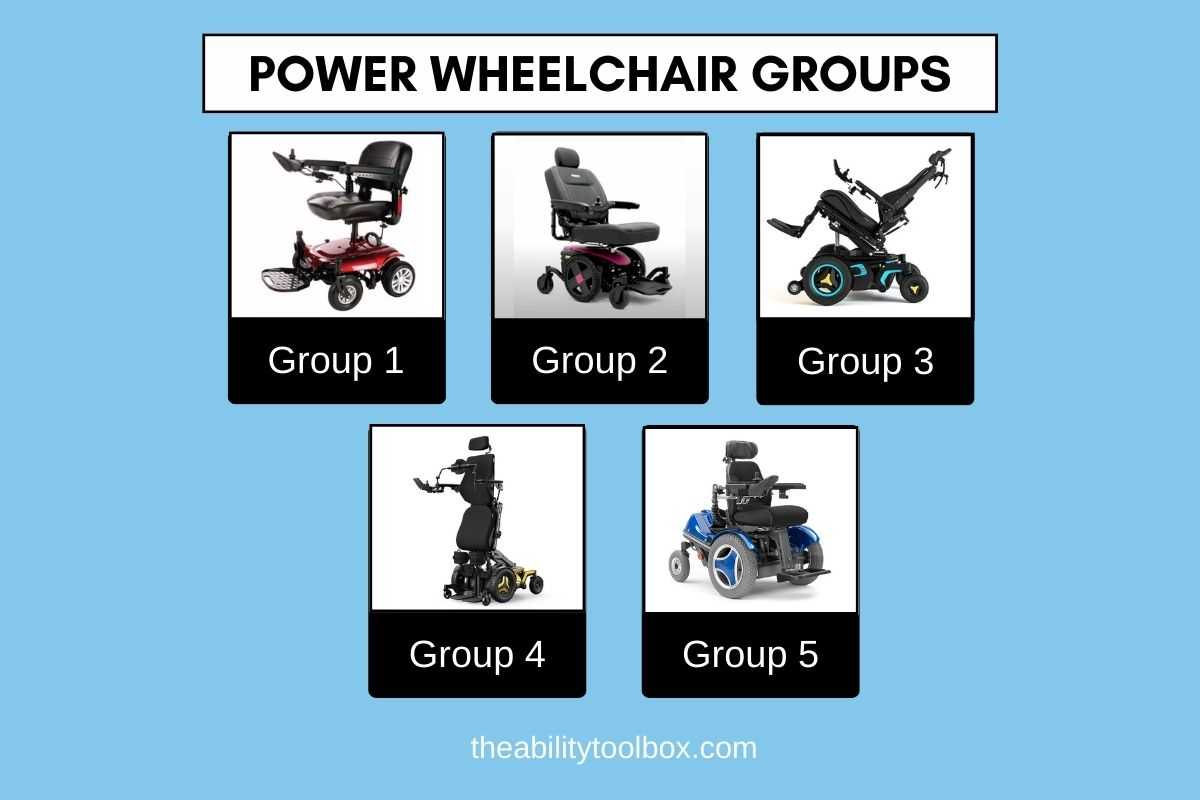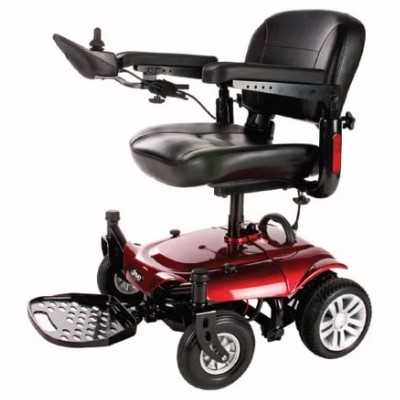
If you're a power wheelchair user, or you're considering getting an electric wheelchair for yourself or someone you love, chances are you'll have to interact with some form of health insurance. Whether you have Medicare, Medicaid, or private insurance, understanding power wheelchair groups and insurance classifications can help you navigate the system and get the mobility equipment you need.
About This Guide
I'm a lifelong power wheelchair user and disability advocate who co-runs a nonprofit that provides refurbished wheelchairs to people in need. I've compiled this guide based on my expertise, research, and recommendations from our community of peer experts here at The Ability Toolbox.
Why You Should Understand Power Wheelchair Groups
Your doctor must prescribe a power wheelchair for you, but most doctors don't know all the ins and outs and features of mobility devices. If you think you might need a power wheelchair, it's best to go into the process informed and knowing what you need and want.
Electric Wheelchairs and HCPCS Codes
The Healthcare Common Procedure Coding System (HCPCS) is a system developed by the Centers for Medicare and Medicaid Services (CMS) to categorize medical products and supplies for processing by health insurance. HCPCS codes designate different groups of wheelchairs, also known as bases, and have separate codes for bariatric (high weight capacity) power wheelchairs in each group.
Wheelchair parts and add-ons such as footrests, seat cushions, and power functions have their own HCPCS codes as well. Unless you're getting a very simple power wheelchair, there will probably be multiple HCPCS codes associated with your device. For your insurance to cover these items, your doctor or physical therapist must provide medical justification as to why you need them. Most medical offices and durable medical equipment suppliers have an employee whose entire job is handling insurance billing and HCPCS coding.
Power Wheelchair Groups
Power wheelchair groups or bases are divided by device capabilities. Each group has multiple HCPCS codes, often based on weight capacity. Here's a simple rundown of each group and who typically uses them, so you can figure out the best electric wheelchair for your needs.
Power Operated Vehicles AKA Mobility Scooters

POVs, better known as mobility scooters, are 3- or 4-wheeled electric devices that steer with a tiller rather than a joystick. They are assigned HCPCS codes K0800-K0812.
Mobility scooters have basic seating that can't accommodate pressure relief cushions. They vary significantly in portability, speed, and capabilities based on the model. Mobility scooters have a wide turning radius and can be difficult to use in homes and tight spaces. They may perform well outdoors in grass and on sidewalks.
Who Should Use a POV/Scooter
Mobility scooters are ideal for people who are partially ambulatory and only need a mobility device for long distances. Since Medicare and most insurance companies require that you need the device for use in your home, it can be harder to get a scooter covered. However, if you're private paying and need a portable device, they can be a great option.
Portable Power Wheelchairs

Lightweight motorized wheelchairs are designed to be easy to transport in a standard vehicle trunk or backseat. They are assigned HCPCS code K0012 and may be categorized as Group 1 or Group 2 devices. However, many portable power wheelchairs on the market today are non-coded, meaning they haven't gone through the process to be covered by Medicare and Medicaid. That means you'll probably have to buy out of pocket, though you can deduct it from your taxes as a medical expense or use a Health Savings Account.
Portable power wheelchairs typically weigh 30 to 80 pounds and fold up to be much smaller than their regular size. They usually come apart so there are no individual heavy pieces to lift. They often use lithium ion batteries which are much lighter and tolerate infrequent charging. Many are airline approved and can fit in the airplane cabin storage closet during flight. Lightweight motorized wheelchairs are best for travel and light use only; they generally can't handle rough terrain.
Who Should Use a Lightweight Motorized Wheelchair
Portable power wheelchairs are excellent for seniors and part-time wheelchair users who want to be more active but don't have an accessible vehicle. They're perfect for air travel as they don't need to go in the cargo hold where they'd be at high risk of being broken. They also make excellent spare wheelchairs as they don't take up much space but provide insurance in case your main power chair breaks down. They are also relatively inexpensive, which is ideal if you are paying out of pocket.
Learn More: The Lightest Folding Electric Wheelchairs for Travel
Group 1 Power Wheelchairs

Group 1 power wheelchairs are basic and no-frills. They are assigned HCPCS codes K0813-K0816. They are intended to be used indoors on level surfaces at slow speeds. They are not ideal for full-time use.
Group 1 electric wheelchairs have basic seating similar to a mobility scooter. They generally can't accommodate pressure relief seat cushions or added supports. Some Group 1 power wheelchairs may fold or be portable.
Who Should Use a Group 1 Power Wheelchair
In most cases, Group 1 power wheelchairs are best suited for seniors and people who don't go out much. Overall, we don't recommend them and suggest that you push for yourself or a loved one to get a portable or Group 2 chair.
Group 2 Power Wheelchairs

A Group 2 power wheelchair is what most people imagine when they think of a standard electric wheelchair. They are assigned HCPCS codes K0820-K0843. They have more powerful motors, slightly faster speeds, a decent battery range, and can navigate city streets and flat grassy areas. A few Group 2 electric wheelchairs are portable, but most are quite heavy and will require an accessible vehicle for transportation.
Some Group 2 power wheelchairs can support simple seating and positioning modifications such as a pressure relief cushion. A few Group 2 electric wheelchairs offer a seat elevator and/or tilt option, but their wheelbases and battery capacity generally aren't robust enough to support complex powered adjustable seating systems.
All Group 2 power wheelchairs must meet the following requirements:
- Minimum Top Speed: 3 mph
- Minimum Battery Range: 7 miles
- Minimum Obstacle Climb: 40 mm (slightly more than 1 1/2 in.)
- Dynamic Stability Incline: 6 degrees
In case you're not familiar with power wheelchair capabilities, those aren't great numbers, especially the top speed and battery range. With that said, many Group 2 electric wheelchairs exceed these requirements.
Who Should Use a Group 2 Power Wheelchair
Group 2 power wheelchairs are well-suited for seniors, partially ambulatory people, and full-time wheelchair users who don't have complex seating and positioning needs. However, they may not meet the needs of active users.
Group 3 Power Wheelchairs

Group 3 power wheelchairs are also known as complex rehabilitation technology electric wheelchairs. They are assigned HCPCS codes K0848-K0864. They are fully customizable for people with disabilities who require custom seating and positioning functions. A Group 3 electric wheelchair has features such as power tilt, recline, and seat elevation. They are not portable and often weigh 300 pounds or more due to all of the seating functions.
Group 3 power wheelchairs are designed for full-time use in and out of the home and offer higher speeds, better obstacle-climbing capability, and longer battery life.
All Group 3 power wheelchairs must meet the following requirements:
- Minimum Top Speed: 4.5 mph
- Minimum Battery Range: 12 miles
- Minimum Obstacle Climb: 60 mm (about 2 3/8 in.)
- Dynamic Stability Incline: 7.5 degrees
- Drive wheel suspension to reduce vibration
As you can see, these capabilities are far superior to Group 2. Many Group 3 electric wheelchairs exceed these requirements as well, offering speeds of 5 to 7 mph and battery ranges of 15 to 20 miles.
Who Should Use a Group 3 Power Wheelchair
Group 3 power wheelchairs are designed to empower people with severe physical impairments to be active in their communities. To qualify for a Group 3 electric wheelchair, you generally must have a neurological condition, a myopathy, or a congenital skeletal deformity. You can also qualify if you have another condition that makes you unable to change positions independently, such as multiple limb amputations.
To get a Group 3 electric wheelchair funded by Medicare and most other insurance providers, you'll need to meet with your doctor, then have an evaluation done by a rehabilitation seating professional such as a physical therapist or occupational therapist.
Group 4 Power Wheelchairs

Group 4 electric wheelchairs have enhanced capabilities such as high performance on outdoor terrain, anterior (forward) tilt, and standing. They are assigned HCPCS codes K0868-K0886.
Group 4 power chairs are generally not covered by insurance. However, Vocational Rehabilitation and/or the Veterans Administration may help pay for Group 4 features such as standing and upgraded motors while insurance covers the rest. You can also work with nonprofit foundations or private pay for the added features.
Who Should Use a Group 4 Power Wheelchair
Group 4 power wheelchairs are effectively Group 3s with added functions. The process to get them is the same, but will have added steps depending on what is required by your other funding sources.
If you need and can benefit from Group 4 functions, we encourage you to push and fight for them. It's worth it!
Group 5 Power Wheelchairs

Pediatric electric wheelchairs are classified as Group 5 and designed for children up to 125 pounds who are expected to grow while using the device. They are assigned HCPCS codes K0890-K0891. They generally have the same seating features as a Group 3 adult power wheelchair, but may be smaller or feature a lower seat-to-floor height.
Who Should Use a Group 5 Power Wheelchair
Group 5 power wheelchairs are mostly used by kids, but can also be prescribed for small adults, such as people with dwarfism.
Finding the Right Power Wheelchair Group for Your Needs
Now that you've read about power wheelchair groups, you're ready for the next stage on your journey. Check out our other articles to learn more about the different types of electric wheelchairs and how to get insurance to pay for a power chair.

Which one of the power wheelchair groups serves your needs best?
Share your experiences in the comments.
Founder and Editor-in-Chief of The Ability Toolbox. I received my BA in English from Stanford University and MA in Clinical Psychology from Antioch University Los Angeles, and have worked in entertainment and health media for over 20 years. I also blog about traveling with a disability. As a wheelchair user with cerebral palsy, I am deeply committed to amplifying the voices of the disability community through writing and advocacy.








Start the discussion at community.theabilitytoolbox.com